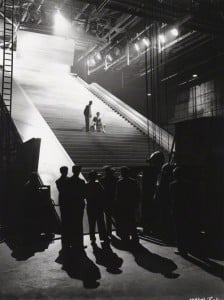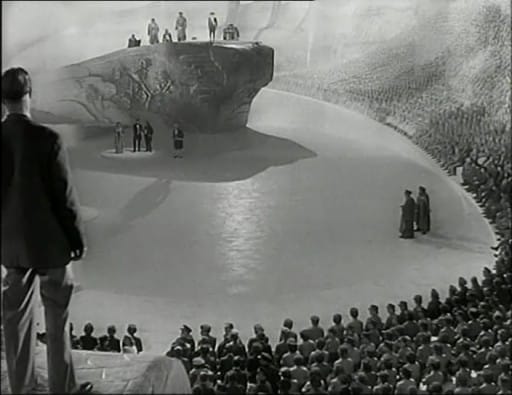
Dir: Michael Powell | Writer: Emeric Pressburger | Cast: David Niven, Roger Livesey, Raymond Massey, Kim Hunter, Marius Goring, Abraham Sofaer, Robert Coote, Joan Maude, Kathleen Byron, Bonar Colleano, Richard Attenborough | UK / Fantasy / 104min
Although by general consensus it is now accorded the status of a classic, it actually took quite a while for this beautiful and unique film to be considered as such. Lindsay Anderson at the time actually used it as his yardstick for mediocrity when he despaired in ‘Sequence’ of audiences that “allow themselves to be diverted by A Matter of Life and Death, but confess themselves too lazy for Ivan the Terrible“, while as recently as 1973 it had been dismissed by Angela & Elkan Allan in ‘The Sunday Times Guide to Movies on Television’ as “[e]xtravagantly awful… told not as a comedy, but as a serious, ludicrous drama”.
 When it first appeared plenty of critics grumbled at its lack of realism, although director Michael Powell himself took great satisfaction in the fact that everything in the film was psychologically explicable as a hallucination on the part of the hero, Peter Carter (engaging played by a young David Niven). The light-hearted backdrop of fantasy, however, made palatable the graphic depiction of the violent death of two of the film’s characters (we first see Bob Trubshawe [Robert Coote] looking very realistically dead with his eyes open), since within the context of the film’s narrative they are both soon depicted jauntily bounding back to life, when in reality at the film’s conclusion they would both have been very much dead, and remained so for all eternity.
When it first appeared plenty of critics grumbled at its lack of realism, although director Michael Powell himself took great satisfaction in the fact that everything in the film was psychologically explicable as a hallucination on the part of the hero, Peter Carter (engaging played by a young David Niven). The light-hearted backdrop of fantasy, however, made palatable the graphic depiction of the violent death of two of the film’s characters (we first see Bob Trubshawe [Robert Coote] looking very realistically dead with his eyes open), since within the context of the film’s narrative they are both soon depicted jauntily bounding back to life, when in reality at the film’s conclusion they would both have been very much dead, and remained so for all eternity.
Under the baton of maestro Michael Powell, A Matter of Life and Death is an enormously satisfying exercise in organisation, with the many components that make up a feature film – Emeric Pressburger’s literate script, the enthusiastic performances by a uniformly fine cast, Jack Cardiff’s Technicolor photography, Allan Gray’s music, Alfred Junge’s production design, Reginald Mills’ editing and so on – smoothly coalescing into a sublime whole, which Powell himself prided himself on making it all look so easy, when it had been anything but. It was typically audacious that the film chose at so early to reverse the convention already emerging in cinematic fantasy by depicting real life in Technicolor and Heaven in black & white. The transitions are smoothly organised, although some took exception at Marius Goring’s line – breaching the fourth wall – that “One is starved for Technicolor up zere…!” Depicting Heaven in black & white was perceived by Raymond Durgnat as satirising the welfare state, and in an odd little book published in 1947 called ‘The World is My Cinema’ E.W. & M.M. Robson heaped page upon page of abuse on the heads of Powell & Pressburger accusing them of being unpatriotic fascist sympathisers (although it’s worth noting that nobody from the Axis Powers is anywhere to be seen, the Chief Recorder is a woman (Joan Maude) and The Judge is played by an Asian actor [Abraham Sofaer]).
 A remarkable amount of Britain’s imperial dirty linen indeed receives a very public airing during the heavenly tribunal (including a laugh-out-loud moment depicting the introduction of an Irish juror in standard IRA uniform of trilby and trenchcoat) led Richard Winnington of the News Chronicle to suppose it was there just for “American box-office purposes”, which ironically attests to the artfulness with which Powell & Pressburger’s company The Archers had camouflaged their propaganda, since the whole reason for the film’s existence had been a request from the Ministry of Information to make a film stressing Anglo-American friendship (relations between the Allies were becoming strained even before Germany surrendered). Anyone else would have simply obliged with a conventional romance between a Brit and a Yank, but The Archers didn’t do conventional, and only they would erect such a formidable edifice to get their message across.
A remarkable amount of Britain’s imperial dirty linen indeed receives a very public airing during the heavenly tribunal (including a laugh-out-loud moment depicting the introduction of an Irish juror in standard IRA uniform of trilby and trenchcoat) led Richard Winnington of the News Chronicle to suppose it was there just for “American box-office purposes”, which ironically attests to the artfulness with which Powell & Pressburger’s company The Archers had camouflaged their propaganda, since the whole reason for the film’s existence had been a request from the Ministry of Information to make a film stressing Anglo-American friendship (relations between the Allies were becoming strained even before Germany surrendered). Anyone else would have simply obliged with a conventional romance between a Brit and a Yank, but The Archers didn’t do conventional, and only they would erect such a formidable edifice to get their message across.
It’s hard to imagine any other national cinema or filmmakers combining such technical and philosophical ambition with such boundless exuberance in its telling. The whole film looks so extraordinary, it’s easy not to notice the skilful use of sound throughout – from the hollow, echoing acoustics of the opening scene narrated by John Longden taking us on a tour of outer space, through the ominously ticking clock in the control room at the air base, to Allan Gray’s exquisite and atmospheric score, his last for an Archers production.
A Matter of Life and Death represents both the culmination and conclusion of The Archers’ first phase, since as their later productions became more ornate they in the process lost much of the gusto and graceful good humour which had characterised their earlier productions. ©RChatten
The film also inspired Alan Price to compose this poem:
A MATTER OF LIFE AND DEATH (1946)
No one has ever dramatised a brain seizure like you guys.
An airman hallucinating on earth and its WW2 ‘heaven.’
Pilot Peter Carter, so English a fighting poet. One moment
in a three-strip Technicolor village, the next on a staircase
to a monochrome beyond. Blaze of aircraft crashing down.
A beach. Her cycling. You meet; grab the falling handlebars,
embrace and kiss. Not some visionary sight of a nether world.
Nor a surgeon spying the street with his camera obscura.
Nor the French messenger who lost his head. Nor the smell
of fried onions can change my mind: the idea of a sacrifice
for love. June got her man. Peter got his woman. Emeric and
you Michael got the film you wanted. AMOLAD determined
my fantasy after-life. I was born premature three years later:
taken out of my pram; nurtured in a cinema, entranced by
black & white pearls with the option for wide screen rainbows.
Hovering betwixt and between, knowing I’d never starve.
©ALAN PRICE